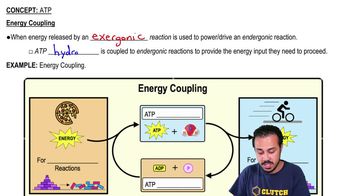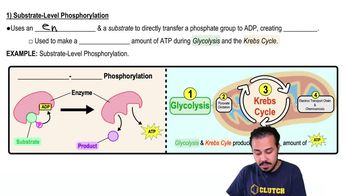Which substance in the following reaction is being reduced?
<IMAGE>
a. acetaldehyde
b. NADH
c. ethanol
d. NAD⁺
 Verified step by step guidance
Verified step by step guidance



Which substance in the following reaction is being reduced?
<IMAGE>
a. acetaldehyde
b. NADH
c. ethanol
d. NAD⁺
Use the following choices to answer questions 7–10.
a. E. coli growing in glucose broth at 35℃ with O₂ for 5 days
b. E. coli growing in glucose broth at 35℃ without O₂ for 5 days
c. both a and b
d. neither a nor b
Which culture uses the most glucose?
DRAW IT Using the following diagrams, show each of the following:
a. where the substrate will bind
b. where the competitive inhibitor will bind
c. where the noncompetitive inhibitor will bind
d. which of the four elements could be the inhibitor in feedback inhibition
e. What effect will the reactions in (a), (b), and (c) have?
<IMAGE>
DRAW IT An enzyme and substrate are combined. The rate of reaction begins as shown in the following graph. To complete the graph, show the effect of increasing substrate concentration on a constant enzyme concentration. Show the effect of increasing temperature.
<IMAGE>
Which of the following processes does not generate ATP?
a. photophosphorylation
b. the Calvin-Benson cycle
c. oxidative phosphorylation
d. substrate-level phosphorylation
e. All of the above generate ATP
Which of the following compounds has the greatest amount of energy for a cell?
a. CO₂
b. ATP
c. glucose
d. O₂
e. lactic acid